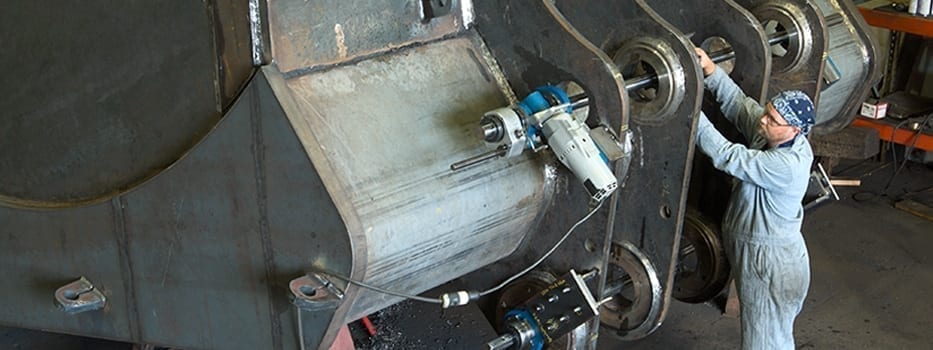
18 Sep LINE BORING WITH FITZ ACHESON: FIVE FREQUENTLY ASKED QUESTIONS
 When planning a line boring machine job, there are dozens of questions customers ask each day. We met up with Fitz Acheson our Applications Engineer and Technical Trainer for CLIMAX and asked him to highlight the five most frequently asked questions he hears with regards to line boring:
When planning a line boring machine job, there are dozens of questions customers ask each day. We met up with Fitz Acheson our Applications Engineer and Technical Trainer for CLIMAX and asked him to highlight the five most frequently asked questions he hears with regards to line boring:
Q1: At what speed should the bar turn when I am machining?
FITZ: This depends on the tooling that you are using and the hole diameter. If you are using high-speed steel (HSS) tooling, typically no greater than 80 surface feet per minute (24 meters per minute) would be recommended. To calculate your target RPM take your SFPM (80) x 4 and divide by diameter (8 inches) = 40 RPM. Another example would be, SFPM (80) x 4 and divide by diameter (4 inches) = 80 RPM. To calculate your target RPM in metric take your MPM (24) x 320 and divide by diameter (203 mm) = 38 RPM. Another example would be, MPM (24) x 320 and divide by diameter (102 mm) = 75 RPM.
Also, when using HSS tooling, your chips should be gray. Blue chips indicate that the HSS is overheating, in which case it loses its hardness and severely reduces machining performance. With carbide tooling, you can run without coolant to roughly 120 SFPM (37 MPM), where a light blue chip indicates its nearing the edge of the speed envelope.
“While customers typically call us for our experience, my favorite part is experiencing the different methods and humor of the talented people we work with around the world. Being able to help and be of service to these people makes everything worthwhile.”
– Fitz Acheson, Applications Engineer and Technical Trainer
Q2: How do I align the boring bar to a hole that is so trashed there isn’t any reference?
FITZ: Typically, when bores are so far gone that there is no reference, a datum or reference must be established. If no prints are available, then make an educated guess of the bore location in relation to specific points on the machine (or heavy equipment). If the job requires high accuracy, then prints and fine measuring equipment may be required to ensure alignment is within the required tolerances.
Q3: What is the best way to measure the bore accurately and set the tool?
FITZ: There are many ways to perform measurements, and typically it is advantageous to have a way to check the accuracy of your bore measurements with a secondary method. Over-the-bar calipers are a quick and fairly accurate way to measure the bore while the bar is still installed. Also, our Bore Measuring Tool measures the distance from the bar to the bore surface, allowing the operator to quickly determine the diameter of the bore. The Bore Measuring Tool also doubles as a tool setting device, helping to index the tool accurately. If these tools are not available, spring calipers and micrometers are the old school way of quickly determining the diameter of the bore. For tool setting, a standard 1-inch (25-mm) throw dial indicator with a mushroom head and a magnetic base will easily and accurately assist the operator in adjusting the tool height. Standard bore measuring tools, such as inside micrometers and T gauges, provide absolute accuracy, but the bar needs to be removed for these measurements.
Q4: How close should the bearings be to the bore being machined?
FITZ: As close as possible to the bore while allowing access to the cutting tool for setting and measuring the tool height. Typically, one bearing can be quite close and the other side is the “tool set and measure” side.
A general rule would be to ensure that no greater than seven times the bar diameter is between the tool and the nearest bearing. Bracing or strutting the CLIMAX bearing mounts in two directions, 90 degrees out from each other, will make for a more rigid setup and enhance accuracy and consistency.
Q5: Which type of tool should I use?
FITZ: Personally, I like to have all options available to me. HSS tooling, while “old school” and slower than carbide in SFPM, is inexpensive, easy to sharpen, and doesn’t fracture like carbide.
Brazed carbide tooling is excellent for machining welded material because it can withstand the high density of grain boundaries in the weld metal without wearing down like HSS does. However, due to carbide’s sensitivity to fracturing, it is wise to have the ability to sharpen the tool bits (silicon carbide wheel), and to have a small fine stone to lightly hone the sharp edge of the carbide bit when roughing.
Carbide insert bits have highly advanced designs with a massive spectrum of choices at hand. Superior finishes and accuracy are easily created without requiring the sharpening skill that the HSS and brazed carbide require. However, insert bits are generally quite expensive, so an operator might use HSS or brazed carbide for roughing and choose an insert-style bit for finishing.
Like so many things in life, each person has their own preferred systems based on their environment, experience, and time limitations.
Do you have additional questions about CLIMAX’s line boring machines? Contact us today to connect with a CLIMAX expert and determine the best solution for your company.


